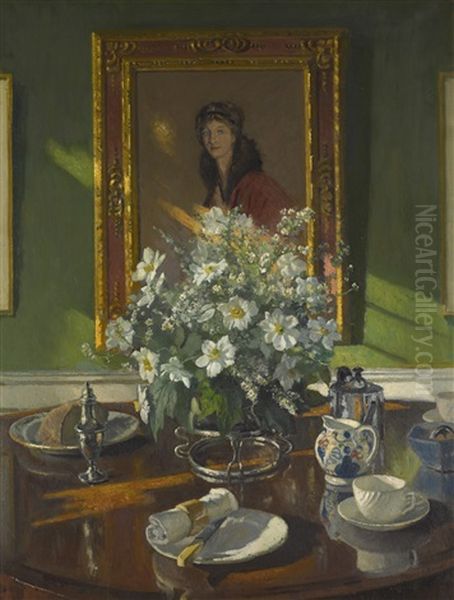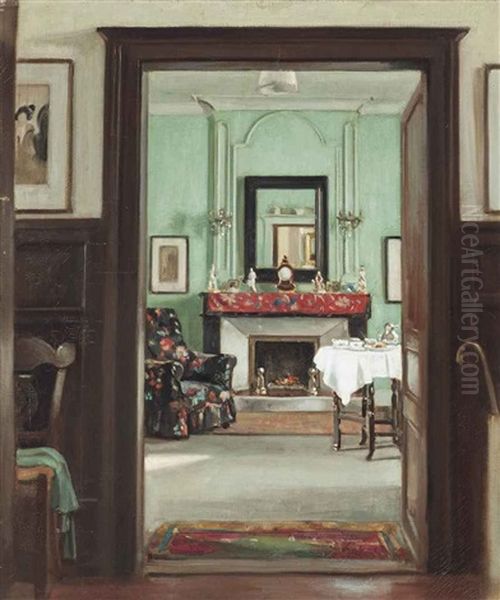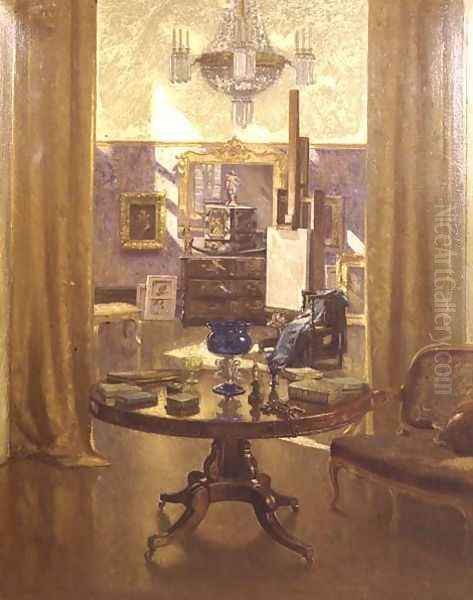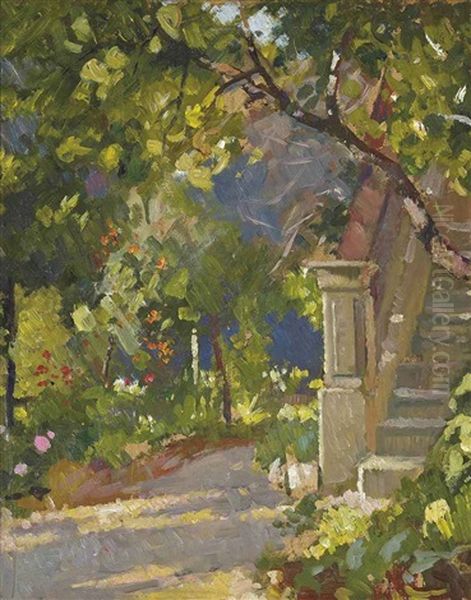
Patrick William Adam stands as a significant figure in Scottish art history, a painter celebrated particularly for his evocative interiors and luminous landscapes. Born in the mid-19th century, his career spanned a period of rich artistic development in Scotland, bridging Victorian traditions with emerging modern sensibilities. Associated with the prestigious Royal Scottish Academy and a co-founder of the influential Society of Eight, Adam carved a distinct niche for himself, leaving behind a body of work admired for its technical skill, sensitivity to light, and quiet elegance.
Early Life and Artistic Formation
Patrick William Adam entered the world in Edinburgh on October 12, 1854 (some sources suggest October 14). His background was respectable; his father was a well-regarded lawyer in the city, providing a stable environment for the young Adam. His initial education took place at the esteemed Edinburgh Academy. However, his inclination towards the arts soon became apparent, leading him to pursue formal training.
His artistic journey began with studies in London, broadening his horizons beyond his native city. Subsequently, he returned to Edinburgh to enrol in the Trustees Academy, which later became the Royal Scottish Academy (RSA) Schools. This institution was the crucible for many of Scotland's finest artists. Here, Adam had the invaluable opportunity to learn under the guidance of two prominent Scottish painters: William McTaggart and George Paul Chalmers. McTaggart, known for his increasingly impressionistic seascapes and landscapes, likely imparted a sensitivity to atmosphere and light, while Chalmers, a master of portraiture and genre scenes with a rich, tonal quality, would have offered insights into figure painting and composition. This training provided Adam with a solid technical foundation upon which he would build his career.
Developing a Distinctive Style
Adam initially gained recognition as a portrait painter, a common starting point for many artists seeking commissions and establishing a reputation. His skill in capturing likenesses was evident early on. However, his artistic interests were broader, and he gradually shifted his focus towards landscapes, still lifes, and, most notably, interior scenes. It was in the depiction of rooms, bathed in natural light, that Adam found his most compelling voice.

His style is often characterised as a form of Impressionistic Realism. While grounded in accurate observation and draughtsmanship, his work demonstrates a keen interest in the transient effects of light and colour, hallmarks of Impressionism. His canvases are often bright and expressive, avoiding heavy chiaroscuro in favour of exploring how light fills a space, reflects off surfaces, and creates mood. He worked primarily in oils, but was also adept with watercolours and pastels, choosing the medium that best suited his subject and desired effect. Floral motifs sometimes appear, adding decorative notes to his compositions, but his primary fascination lay in the interplay of light and shadow within architectural spaces.
The Celebrated Interiors
While Adam produced accomplished works across several genres, his interior paintings are widely considered his most significant contribution and represent the pinnacle of his achievement. He possessed an exceptional ability to capture the atmosphere of domestic spaces, often depicting elegant drawing rooms, libraries, or dining rooms, frequently within his own homes or those of friends and patrons. These were not merely architectural records; they were intimate portrayals of lived-in spaces, imbued with a sense of tranquility and refinement.
A key element in Adam's interiors is his masterful handling of light. He favoured scenes illuminated by natural daylight, often streaming through windows, casting soft shadows and highlighting the textures of fabrics, polished wood, and porcelain. His paintings explore the subtleties of reflected light and the way sunlight can transform an ordinary room into a space of quiet beauty. Works such as Interior, Rutland Square or The Breakfast Table exemplify this focus, showcasing his skill in rendering complex light effects and creating a palpable sense of presence. His later interiors, painted at his home 'Ardilea' in North Berwick, continued this exploration, often featuring sun-drenched rooms overlooking gardens or the sea. While distinct in their Scottish sensibility, his dedication to the interior genre invites comparisons with European contemporaries like the French Intimists, Pierre Bonnard and Édouard Vuillard, though Adam generally maintained a more structured, realistic approach than the Nabis painters.
Landscapes and Travels
Adam's oeuvre also includes a significant number of landscape paintings. His travels provided rich subject matter. He journeyed to continental Europe, visiting artistic centres such as Paris, Rome, and Venice. These experiences undoubtedly broadened his artistic perspective and exposed him firsthand to different qualities of light and landscape, as well as the work of European masters and contemporaries. A trip to Russia is also documented, adding another layer to his visual experiences.

His landscape work often reflects the same sensitivity to light and atmosphere found in his interiors. He painted scenes from his travels, capturing the unique character of Venetian canals or the Roman countryside. However, he also remained deeply connected to his native Scotland, frequently depicting the landscapes of East Lothian, particularly after settling in North Berwick. These works often possess a fresh, open-air quality, possibly influenced by his early teacher, William McTaggart, and perhaps showing an awareness of the plein-air approaches favoured by the French Impressionists like Claude Monet or Camille Pissarro. The specific mention of an "East Lothian Collection" suggests a focused body of work dedicated to this region, known for its picturesque coastline and rolling countryside.
Engagement with the Art World: The RSA
Patrick William Adam was deeply integrated into the Scottish art establishment, particularly through his long association with the Royal Scottish Academy. His connection began early; he first exhibited at the RSA at the young age of 18. Over his career, he would become a prolific exhibitor, with records indicating he showed a total of 164 paintings at the Academy's prestigious annual exhibitions.
His talent was recognised with accolades. In 1877, he won the RSA's Stuart Prize for Life Drawing, a testament to his foundational skills. The following year, 1878, he was awarded the Maclane Watters medal. His standing within the Academy grew steadily. He was elected an Associate of the Royal Scottish Academy (ARSA) in 1884, and achieved the full rank of Academician (RSA) in 1897. This position cemented his status as one of Scotland's leading painters. He remained an active participant in the RSA's activities and exhibitions throughout his life, contributing to the vibrant artistic life of Edinburgh. His contemporaries at the RSA included figures like Sir James Guthrie, a leading Glasgow Boy who later became RSA President.
The Society of Eight
Beyond the RSA, Adam played a key role in founding the Society of Eight in 1912. This exhibiting society was formed by a group of friends and colleagues who sought to create an alternative, perhaps more progressive, exhibiting platform. A stated aim was to bridge the perceived artistic divide between Edinburgh and Glasgow, two cities with distinct and sometimes rivalrous art scenes. The Glasgow School (the "Glasgow Boys"), including figures like Sir John Lavery and James Paterson, had brought international attention to the western city, while Edinburgh maintained its own strong traditions centred around the RSA.

The initial members of the Society of Eight were Adam himself, David Alison, F.C.B. Cadell, Sir John Lavery, S.J. Peploe, and James Paterson. This grouping was significant, bringing together established figures like Lavery and Paterson (associated with the Glasgow Boys) with emerging talents like Cadell and Peploe, who would become central figures in the Scottish Colourist movement alongside J.D. Fergusson and G.L. Hunter. Adam, respected in Edinburgh circles, acted as a crucial link. Later, artists such as Arthur Melville (though he died in 1904, his influence persisted), E. A. Walton, and potentially Adam's former teachers McTaggart and Chalmers, were associated or exhibited with the group, demonstrating its appeal across different artistic generations and styles. The Society held exhibitions in Edinburgh, often at the New Gallery in Shandwick Place, providing a showcase for modern Scottish painting. Although the society's activities were eventually curtailed, likely impacted by events like the First World War and later the Second World War (long after Adam's death), its formation was an important moment in fostering collaboration and dialogue within the Scottish art scene.
Contemporaries and Context
Adam worked during a dynamic period in British and European art. In Scotland, the late 19th and early 20th centuries saw the flourishing of the Glasgow Boys (including Lavery, Paterson, Guthrie, E.A. Hornel, George Henry) who brought a new realism and decorative sense to Scottish painting, often influenced by French realism and plein-air painting. Following them came the Scottish Colourists (Peploe, Cadell, Hunter, Fergusson), known for their bold use of colour and expressive brushwork, clearly influenced by French Post-Impressionism and Fauvism.
Adam navigated these currents, maintaining his own distinct path. While friendly with members of both groups, particularly through the Society of Eight, his style remained generally more restrained and realistic than the Colourists, yet lighter and more attuned to atmospheric effects than some of the earlier Glasgow Boys. His work can be seen in the context of other British painters interested in light and interior, such as the American expatriates James McNeill Whistler and John Singer Sargent, whose sophisticated handling of tone and composition resonated internationally. In England, artists like Walter Sickert were also exploring intimate interiors and the effects of light, albeit often with a grittier, more urban sensibility. Adam's work, however, retains a uniquely Scottish character, rooted in the specific light and environment of his homeland.
Later Life, Personality, and Legacy
In 1908, Adam made a significant move, settling in North Berwick, a coastal town in East Lothian. He acquired a property named 'Ardilea', which featured a studio and became his primary residence and place of work for the remainder of his life. Many of his acclaimed later interiors were painted within Ardilea, capturing its rooms and views.

Contemporaries described Adam as a man of great charm and vitality. One friend famously remarked, "Even if he had never painted anything, he would have been great," suggesting a charismatic and engaging personality that transcended his artistic output. He was reportedly active in the social and cultural life of Edinburgh and later North Berwick, involved in organizing events and known for his generosity and willingness to help friends and fellow artists. This is further evidenced by his dedicated service to the Scottish Artists' Benevolent Association, where he held the positions of Honorary Secretary and Vice-President, working to support artists in need. Despite advancing years, he was described as retaining a youthful spirit, an "evergreen creature."
Patrick William Adam passed away at his home, Ardilea, in North Berwick on December 27, 1929, at the age of 75 (or 77 based on the 1854 birth year). He was buried in the North Berwick cemetery.
His legacy rests on his significant contribution to Scottish painting, particularly his mastery of the interior genre. He captured the elegance and tranquility of domestic spaces with a remarkable sensitivity to light and atmosphere. His work provides a valuable visual record of upper-middle-class life in late Victorian and Edwardian Scotland. As an Academician of the RSA and a founder of the Society of Eight, he was a respected figure within the Scottish art world, connecting different generations and artistic factions. His paintings are held in major public collections, including the National Galleries of Scotland, Aberdeen Art Gallery, and various municipal collections throughout Scotland, ensuring his refined vision continues to be appreciated. Patrick William Adam remains an important painter, admired for his technical finesse and his ability to find profound beauty in the quiet corners of everyday life.